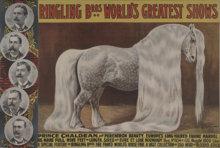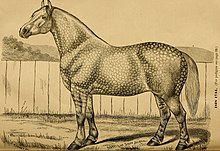 | |
| Species | Horse |
|---|---|
| Breed | Percheron |
| Sex | Male |
| Born | 1877 Eure-et-Loir |
| Owners | Mark Wentworth Dunham, Geo Babcock (d), Ringling Brothers Circus |
| Parent(s) | Coco (d) Superior 730 mare |
Prince Chaldean (also known as Chaldean 854 and Chaldean 637) is a Percheron gray stallion, known for his very long, abundant mane. Born in the Perche region of France in 1877, he was exported as a youngster to the United States, where he was briefly owned by Mark Wentworth Dunham, who sold him a few months later to Mr. Babcock in Wisconsin. Chaldean became a popular local breeding stallion.
He earned his nickname "Prince Chaldean" when he toured with the Ringling Brothers Circus from 1892 onwards. He was presented as the most beautiful and heaviest Percheron horse ever to arrive in the United States. One of his daughters, the mare Isis 1744, is the dam of three famous stallions, Primus 5705, Horus 6491, and Ilderim 10356.
History
Chaldean was born in 1877 in the department of Eure-et-Loir, France. He was imported as a young foal by the famous horse owner and breeder Mark Wentworth Dunham, to his stud in the town of Wayne, Illinois in the USA, the same year. His coat color was black.
Property of Babcock
In February 1878, it was acquired by a man named H. A. Babcock (according to the U.S. Register and the Breeder's Gazette), residing in Neenah, Wisconsin. However, author Jean-Léo Dugast attributes the name Geo Babcock to its owner, specifying that he resides in Appleton. Chaldean was bred from the age of 43. Babcock testified that his horse had "never been beaten in a show ring". By 1890, while still owned by Babcock, Chaldean's coat color had changed to gray.
Circus career

The stallion first took part in Ringling Brothers circus shows in 1892, which presented him as the heaviest and most handsome Percheron ever exported to the USA, under the name "Prince Chaldean, The Percheron Beauty ". Contextualizing all shows involving physically challenged circus animals, including the Ringling Brothers circus, skeptical investigator Joe Nickell notes that these animals were often integrated into sideshows (entresorts), shows presented separately from the main tent, based on capturing the audience's interest through bon mots. Numerous animals with physical peculiarities, including horses, were exhibited in the great American circus shows of the period.
Prince Chaldean, for example, was exhibited in Wisconsin in 1892. For the occasion, the Ringling Brothers circus distributed press releases to the local American press, promoting the horse's appearance; at the same time, it distributed another press release promoting "the biggest hippopotamus in the world".
Description

Chaldean is a Percheron horse. This stallion is best known for his very long, abundant mane. It reached a length of over 2.20 m (7 feet 4 inches) in 1890, according to its second owner Babcock. This feature was described in the Breeder's Gazette as "out of the ordinary". His mane was measured at 9 feet and two inches (2 meters and 80 centimeters) two years later, in 1892, his tail being the same length.
His weight exceeded 1,800 pounds (810 kg) in 1892.
He is registered as a black-coated horse in the Stud-book percheron, but the Breeder's Gazette and author Jean-Léo Dugast report, based on the study of iconographic documents, that he was more likely gray, his color having gradually changed after his birth.
Origins
There is disagreement about Chaldean's origins. The French Studbook (1883), the American Percheron Studbook (1888) and the Breeder's Gazette of 1890 all report him as the son of a stallion named Coco, himself a son of Coco II 714. This makes Chaldean a grandson of Coco II 714. Author Jean-Léo Dugast states that his father was the stallion Coco II 714.
His mother is a daughter of Superior 730.
| (Prince Chaldean °1877) | ||||||||||||||||||||||||||||||||||||||||||||||||||||||||||||||||||||||||||||||||||||||||||||||||||||||||||||||||||||||||||||||||||||||||||||||||||||||||||||||||||||||||||||||||||||||||||||||||||||||||||||||||||||||||||||||||||||||||||||||||||||||||||||||||||||||||||||||||||||||||||||||||||||||||||||||||||||||||||||||||||||||||||||||||||||||||||||||||||||||||||||||||||||||||||||||||||||||||||||||||||||||||||||||||||||||||||||||||||||||||||||||||||||||||||||||||||||||||||||||||||||||||||||||||||||||||||||||||||||||||||||||||||||||||||||||||||||||||||||||||||||||||||||||||||||||||||||||||||||||||||||||||||||||||||||||||||||||||||||||||||||||||||||||||||||||||||||||||||||||||||||||||||||||||||||||||||||||||||||||||||||||||||||||||||||||||||||||||||||||||||||||||||||||||||||||||||||||||||||||||||||||||||||||||||||||||||||||||||||
|---|---|---|---|---|---|---|---|---|---|---|---|---|---|---|---|---|---|---|---|---|---|---|---|---|---|---|---|---|---|---|---|---|---|---|---|---|---|---|---|---|---|---|---|---|---|---|---|---|---|---|---|---|---|---|---|---|---|---|---|---|---|---|---|---|---|---|---|---|---|---|---|---|---|---|---|---|---|---|---|---|---|---|---|---|---|---|---|---|---|---|---|---|---|---|---|---|---|---|---|---|---|---|---|---|---|---|---|---|---|---|---|---|---|---|---|---|---|---|---|---|---|---|---|---|---|---|---|---|---|---|---|---|---|---|---|---|---|---|---|---|---|---|---|---|---|---|---|---|---|---|---|---|---|---|---|---|---|---|---|---|---|---|---|---|---|---|---|---|---|---|---|---|---|---|---|---|---|---|---|---|---|---|---|---|---|---|---|---|---|---|---|---|---|---|---|---|---|---|---|---|---|---|---|---|---|---|---|---|---|---|---|---|---|---|---|---|---|---|---|---|---|---|---|---|---|---|---|---|---|---|---|---|---|---|---|---|---|---|---|---|---|---|---|---|---|---|---|---|---|---|---|---|---|---|---|---|---|---|---|---|---|---|---|---|---|---|---|---|---|---|---|---|---|---|---|---|---|---|---|---|---|---|---|---|---|---|---|---|---|---|---|---|---|---|---|---|---|---|---|---|---|---|---|---|---|---|---|---|---|---|---|---|---|---|---|---|---|---|---|---|---|---|---|---|---|---|---|---|---|---|---|---|---|---|---|---|---|---|---|---|---|---|---|---|---|---|---|---|---|---|---|---|---|---|---|---|---|---|---|---|---|---|---|---|---|---|---|---|---|---|---|---|---|---|---|---|---|---|---|---|---|---|---|---|---|---|---|---|---|---|---|---|---|---|---|---|---|---|---|---|---|---|---|---|---|---|---|---|---|---|---|---|---|---|---|---|---|---|---|---|---|---|---|---|---|---|---|---|---|---|---|---|---|---|---|---|---|---|---|---|---|---|---|---|---|---|---|---|---|---|---|---|---|---|---|---|---|---|---|---|---|---|---|---|---|---|---|---|---|---|---|---|---|---|---|---|---|---|---|---|---|---|---|---|---|---|---|---|---|---|---|---|---|---|---|---|---|---|---|---|---|---|---|---|---|---|---|---|---|---|---|---|---|---|---|---|---|---|---|---|---|---|---|---|---|---|---|---|---|---|---|---|---|---|---|---|---|---|---|---|---|---|---|---|---|---|---|---|---|---|---|---|---|---|---|---|---|---|---|---|---|---|---|---|---|---|---|---|---|---|---|---|---|---|---|---|---|---|---|---|---|---|---|---|---|---|---|---|---|---|---|---|---|---|---|---|---|---|---|---|---|---|---|---|---|---|---|---|---|---|---|---|---|---|---|---|---|---|---|---|---|---|---|---|---|---|---|---|---|---|---|---|---|---|---|---|---|---|---|---|---|---|---|---|---|---|---|---|---|---|---|---|---|---|---|---|---|---|---|---|---|---|---|---|---|---|---|---|---|---|---|---|---|---|---|---|---|---|---|---|---|---|---|---|---|---|---|---|---|---|---|---|---|---|---|---|---|---|---|---|---|---|---|---|---|---|---|---|---|---|---|---|---|---|---|---|---|---|---|---|---|---|---|---|---|---|---|---|---|---|---|---|---|---|---|---|---|---|---|---|---|---|---|---|---|---|---|---|---|---|---|---|---|---|---|---|---|---|---|---|---|---|---|---|---|---|---|---|---|---|---|---|---|---|---|---|---|---|---|---|---|---|---|---|---|---|---|---|---|---|---|---|---|---|---|---|---|---|---|---|---|---|---|---|---|---|---|---|---|---|---|---|---|---|---|---|---|---|---|---|---|---|---|---|---|---|---|---|---|---|---|---|---|---|---|---|
| ||||||||||||||||||||||||||||||||||||||||||||||||||||||||||||||||||||||||||||||||||||||||||||||||||||||||||||||||||||||||||||||||||||||||||||||||||||||||||||||||||||||||||||||||||||||||||||||||||||||||||||||||||||||||||||||||||||||||||||||||||||||||||||||||||||||||||||||||||||||||||||||||||||||||||||||||||||||||||||||||||||||||||||||||||||||||||||||||||||||||||||||||||||||||||||||||||||||||||||||||||||||||||||||||||||||||||||||||||||||||||||||||||||||||||||||||||||||||||||||||||||||||||||||||||||||||||||||||||||||||||||||||||||||||||||||||||||||||||||||||||||||||||||||||||||||||||||||||||||||||||||||||||||||||||||||||||||||||||||||||||||||||||||||||||||||||||||||||||||||||||||||||||||||||||||||||||||||||||||||||||||||||||||||||||||||||||||||||||||||||||||||||||||||||||||||||||||||||||||||||||||||||||||||||||||||||||||||||||||
The Ringling brothers describe him as a "noble" animal with an "impeccable pedigree".
Descent and homage

Chaldean is said to have been a very popular sire, producing between 75 and 90 foals a year. All his foals would be gray, whatever the color of the mom.
One of his daughters, registered in the American Percheron Studbook, is the mare Isis 1744, dam of Primus 5705, Horus 6491, and Ilderim 10356, the latter presented by H.C. Farnum and awarded third prize at the Detroit International Show in 1890.
| Prince Chaldean °1877 | |||||||||||||||||||||||||||||||||||
| Isis 1744 °1881 | |||||||||||||||||||||||||||||||||||
| Primus 5705 °1886 | Horus 6491 °1887 | Ilderim 10356 | |||||||||||||||||||||||||||||||||
| Flora 23908 °1899 | Don 23907 | Hattie 29785 | Sverdrup 51628 °1905 | ||||||||||||||||||||||||||||||||
In 1889, American illustrator Lou Burk drew Chaldean to illustrate the cover of an issue of the Breeder's Gazette, published on May 28, 1890. This illustration is described as being very accurate with the horse used as a model.
See also
References
- ^ Dugast (2023, p. 43)
- ^ Percheron Horse Association of America (1888, p. 156)
- ^ The Breeder's Gazette: A Weekly Publication Devoted ... to the Interests of Live-stock Breeders. J.H. Sanders Publishing Company. 1890.
- ^ The Wisconsin Farmer. Wisconsin Farmer Company. 1892.
- Nickell, Joe (2005). Secrets of the Sideshows. University Press of Kentucky. ISBN 978-0-8131-2358-5. JSTOR j.ctt2jcf40.
- Chemers, M. (2016-04-29). Staging Stigma: A Critical Examination of the American Freak Show. Springer. ISBN 978-0-230-61681-3.
- Circus Historical Society (1993-03-01). Bandwagon Vol 37 No 2 (1993).
- ^ Dugast, Jean-Léo (2014-04-01). Cheval percheron, cheval du monde (in French). Editions de l'Etrave. ISBN 978-2-35992-024-6.
- Huÿs, Charles du (2015-06-15). The Percheron Horse. LULU Press. ISBN 978-1-330-30243-9.
- Sanders, Alvin Howard (1917). A History of the Percheron Horse: Including Hitherto Unpublished Data Concerning the Origin and Development of the Modern Type of Heavy Draft, Drawn from Authentic Documents, Records and Manuscripts in the National Archives of the French Government, Together with a Detailed Account of the Introduction and Dissemination of the Breed Throughout the United States, to which is Appended a Symposium Reflecting the View of Leading Contemporary Importers and Breeders Touching the Selection, Feeding and General Management of Stallions, Brood Mares and Foals. Breeder's Gazette Print.
- ^ Société hippique percheronne (1883, p. 51)
- "Accueil". SHPF (in French). Retrieved 2024-06-13.
- Charles, Amélie (2023-06-06). "La généalogie du Percheron…". Généalogie des chevaux (in French). doi:10.58079/12lco. Retrieved 2024-06-13.
- Farnum, Savage and (1888). Island Home Stud of Percheron Horses. John F. Eby & Company.
- The American Breeders and Importers Percheron Registry. The Company. 1911.
- The Breeder's Gazette: A Weekly Publication Devoted ... to the Interests of Live-stock Breeders. J.H. Sanders Publishing Company. 1890.
Bibliography
- Société hippique percheronne (1883). Stud-book percheron de France, vol. I et II, Nogent-le-Rotrou, Société hippique percheronne.
- Percheron Horse Association of America (1888). Percheron Horse Association of America, Percheron Stud Book of America, vol. I à IV, Percheron society of America.
- Dugast, Jean-Léo (2023). L'épopée percheronne. Éditions de l'Étrave. ISBN 978-2-35992-089-5.